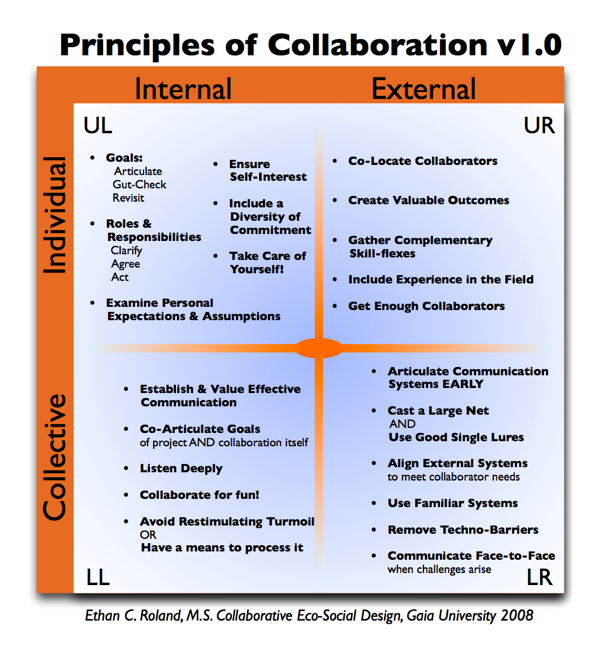The software development world is doing excellent work to move holistic & dynamic design processes forward. My friend and Gaia University colleague Patrick Gibbs pointed me to an ‘Agile Manifesto‘ for software development, whose principles seem very applicable to collaborative eco-social & permaculture design.
You can find the principles here: http://agilemanifesto.org/principles.html
I’ve re-organized them, pulling the most-useful for ecological and social landscape design to the top. I’ve also replaced the word “software” with “outcome” to generalize the ideas. I’ve slightly altered a few of the principles and marked them with an asterisk*. If there is an immediately corresponding permaculture principle, I’ve included it afterwards in (parentheses).
MOST USEFUL FOR DESIGN PROCESS
- Simplicity–the art of maximizing the amount of work not done–is essential. (Pc Principle: Leverage)
- Welcome changing requirements, even late in development. Agile processes harness change for the customer’s competitive advantage. (Pc Principle: Creatively use and respond to change)
- Functional outcomes are the primary measure of progress*. (Pc Principle: Obtain a yield)
MOST USEFUL FOR SOCIAL PROCESS
- Build projects around motivated individuals. Give them the environment and support they need, and trust them to get the job done.
- The most efficient and effective method of conveying information to and within a development team is face-to-face conversation.
- At regular intervals, the team reflects on how to become more effective, then tunes and adjusts its behavior accordingly. (Pc Principle: Apply self-regulation and accept feedback)
- The best architectures, requirements, and designs emerge from self-organizing teams.
- Business people and designers must work together daily throughout the project.*
OTHER PRINCIPLES
- Our highest priority is to satisfy the customer through early and continuous delivery of valuable outcomes.
- Deliver working outcomes frequently, from a couple of weeks to a couple of months, with a preference to the shorter timescale.
- Agile processes promote sustainable development. The sponsors, designers, and users should be able to maintain a constant pace indefinitely.*
- Continuous attention to technical excellence and good design enhances agility.
Several of these agile principles map very closely to the Principles of Collaboration I articulated for my Master’s Thesis at Gaia University:
 Fertile ground! what do y’all think? Anybody using similar principles in their design work?
Fertile ground! what do y’all think? Anybody using similar principles in their design work?


very interesting post. One of my favorite project management books is Radical Project Management http://books.google.com/books?id=W1xQlOjIQH4C&lpg=PP1&ots=a0yeuUjTbZ&dq=radical%20project%20management&pg=PP1#v=onepage&q=&f=false
Kia ora Ethan
I am a permaculture and free culture enthusiast based in Aotearoa (NZ). I am currently writing a paper on the synergies between agile development and permaculture, free culture and slow culture for the FreeCulture2010 conference at the Free University of Berlin. Love you work, especially the Wilber-inspired 4 quadrant stuff. I wonder if it’s our mutual interest in Integral that led us both to make the non-obvious connections between Agile and permaculture? I’m not familiar with spiral dynamics yet, looking forward to integrating that as I continue my research.
Ka nui te mihi
Strypey
It is fine to find to “listen deeply” it has been key to accomplish real permaculture design pre-proyects in México. Clients often express their real goals during first interviews, surely during the first phone call contact. the client always appreciate your real hearing.
Ana at your service
Excellent Post!!
I’m an agile practitioner in japan. And now, I’ve been learning permaculture design recently. As you say, I also think that agile principle is useful for eco-social & permaculture design. Moreover permaculture design principle is useful for software system development too.
For example, Kent Beck, one of the fathers of eXtreme Programming(XP) which is one of the most famous methodologies of agile software development, refered to permaculture in his XP book about “edge effect between developer and customer”. There is his comments on c2.com(http://c2.com/cgi/wiki?PermaCulture).
Agile development also refer to Christopher Alexander’s “A Pattern Language” and “Timeless Way of Building”. Pattern Language is important in permaculture context, isn’t it?
Both is the way of growing dynamic and complex system. I think that there are more valuable and exchangable ideas each other.
—
best regards,
-Takeshi